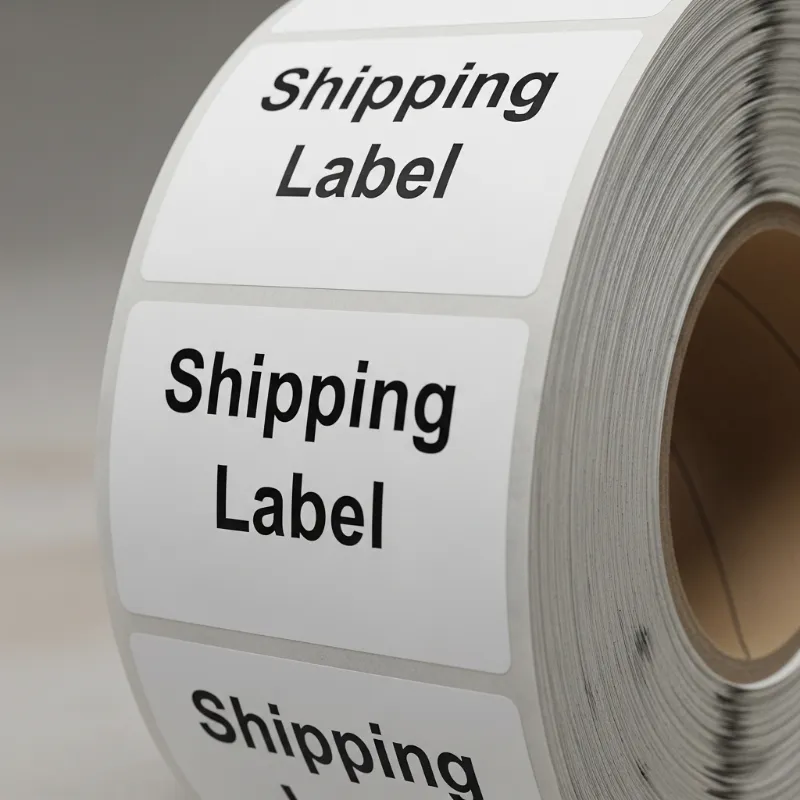
Shipping labels printable are like ID tags for packages. They display addresses, tracking codes, and carrier information, helping packages reach the right destination quickly and safely. Many small businesses rely on shipping labels printable at home or online, saving both time and money.
Shipping labels printable allow you to access cheaper shipping rates, even if you don’t ship frequently.
Automatically generating shipping labels printable helps prevent costly errors.
Printing multiple shipping labels printable at once and comparing rates helps keep shipping expenses low.
Key Takeaways
Shipping labels are like ID tags for packages. They show who sent the package and who will get it. They also have tracking codes and delivery info. This helps packages get to the right place fast and safe.
Making shipping labels online saves time and cuts down on mistakes. It can also give you lower shipping prices. This is very helpful for businesses that send lots of packages.
Printing shipping labels at home saves money. You need the right printer and label size. Thermal printers are best. They make clear and strong labels that scan easily.
Always check the label details before printing. Print a test page first. Put labels on flat and clean spots on the box. This helps stop delivery problems and keeps tracking smooth.
After you put on the label, take the package to the carrier or set up a pickup. Tracking barcodes help both senders and receivers see where the package is on its trip.
Shipping Label Basics
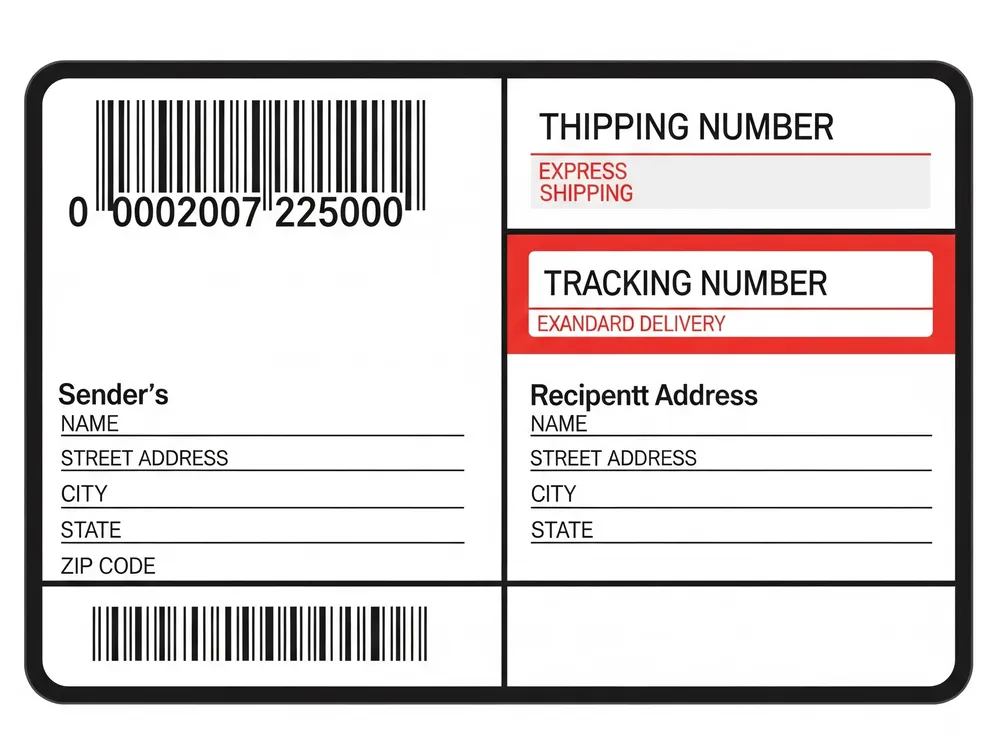
What They Are
Shipping labels work like passports for packages. They show where a package starts and where it should go. They also tell how to get it there. Each label sticks to the outside of a box or envelope. Carriers such as USPS, FedEx, and UPS scan these labels at every stop. Scanning helps the package move the right way. It also updates tracking information.
A shipping label does more than just show an address. It has all the details a carrier needs to deliver a package safely and on time. When someone ships a package, the label is the main information source for the sender and carrier. If a package gets lost, the label helps find it. If a customer wants to track their order, the barcode on the label makes that possible.
Tip: Always check the label before you ship. Even a small mistake can send a package to the wrong place.
What They Include
Most shipping labels from big carriers have the same main parts. Each part has a special job:
Sender’s Information: Shows who sent the package and where it started. This helps if you need to return it or have questions.
Recipient’s Information: Lists the full address for delivery, including apartment or suite numbers.
Package Weight: Tells the carrier how heavy the package is. This changes the shipping cost.
Destination Postal Code: Helps sort and send the package quickly.
Shipping Class or Service Level: Shows if the package goes by ground, priority, or express.
Tracking Barcode and Number: Lets carriers and customers follow the package’s trip.
Here’s a quick look at how different carriers make their labels:
Carrier | Label Size | Barcode & Tracking | Service Level | Special Features |
|---|---|---|---|---|
UPS | 4×6 in or 8.5×11 in | Barcode at bottom; tracking starts with “1Z” | Accessorial codes | Saturday Delivery |
USPS | 4×6 in or 8.5×11 in | IMpb barcode | First Class, Priority, Express | APO/FPO formatting |
FedEx | 4×6 in or 8.5×11 in | Varies by service | Service and billing info at top | Dry ice, hazardous labels |
Barcodes on these labels hold tracking data. Carriers scan them at each stop. This updates the package’s status and location right away. Customers can check this online or in an app. This system helps stop mistakes and keeps everyone updated.
Create Shipping Labels
Online Tools
Many small businesses use online tools to make shipping labels fast. These tools help people avoid mistakes and save time. Some popular choices are ShipStation, CraftMyPDF.com, and Shopify’s free label maker. Each tool has different features, but all try to make shipping easy.
ShipStation is known for its automation. It connects to online stores and gets order details. Users do not need to type addresses or package info by hand. ShipStation lets users print many labels at once. This helps businesses ship faster and make fewer mistakes.
CraftMyPDF.com has a free online shipping label maker. It is good for small businesses that ship one or many packages. The tool has templates you can change and is easy to use. Users can add their logo or brand to make labels look nice. The site makes instant PDFs, so users can print labels right away.
Shopify’s shipping label tool is also popular. Users enter sender and receiver info online. The tool makes a professional label for sticker paper. Shopify’s tool is free and simple, so it is good for beginners.
Other popular online providers and template sources are:
Avery
Sendcloud
Canva
USPS, FedEx, and UPS websites
SheetLabels.com
Microsoft Create
Most online tools let users pick blank or pre-made templates. They can add a business logo, change fonts, or move things around. This helps brands look special and more trusted by customers.
Tip: Adding a logo or design to shipping labels makes packages look better and helps people remember your brand.
Online shipping label tools are different in price, features, and how they work with e-commerce sites. Here is a quick comparison:
Platform | Cost Structure | Key Features | E-commerce Integration |
|---|---|---|---|
ShipStation | From $9/month | Automation, batch printing, discounted rates | Shopify, WooCommerce, and more |
Pirate Ship | Free (pay only postage) | Bulk label creation, no subscription fees | USPS, UPS focus, small business ready |
Ordoro | Starts at $59/month | Inventory management, 3PL integrations | Multi-channel, inventory-heavy stores |
Shippo | Free plan; $0.05 per label | Real-time tracking, multi-carrier support | Many platforms supported |
Easyship | Free up to 50 shipments/month | Global carriers, customs, fulfillment | Amazon, eBay, international |
Online tools help users avoid typos and missing info. They often fill in customer details for you. This saves time and cuts down on mistakes. Many tools give cheaper shipping rates and automatic tracking numbers. For businesses that ship a lot, these features really help.
In-Store and Manual Options
Some people like to make shipping labels in person or by hand. This works best for those who ship only a few packages or need special care. Stores like The UPS Store and FedEx Office print labels in person. Customers can email their label file or show a QR code at the counter. Staff will print the label for a small fee.
Retail Store | In-Person Label Printing | Average Cost Information |
|---|---|---|
The UPS Store | Yes | Not specified |
FedEx Office | Yes | Small fee may apply |
Walmart | No | N/A |
Handwritten labels are still used for some shipments, like international packages or those needing customs forms. When writing labels by hand, users must write clearly and include all details. Mistakes can cause lost or late packages.
Making labels by hand takes more time and can cause errors. Clear handwriting is important, but mistakes still happen. Online tools lower these risks by filling in info and adding tracking codes. They also let you make many labels at once, which you cannot do by hand.
Note: For big shipments or many orders, online tools are more accurate and save time. Manual ways work best for one-time shipments or special needs.
Making shipping labels does not have to be hard. Online tools and in-store services give people many choices. By picking the right way, anyone can ship packages easily and with confidence.
Shipping Labels Printable
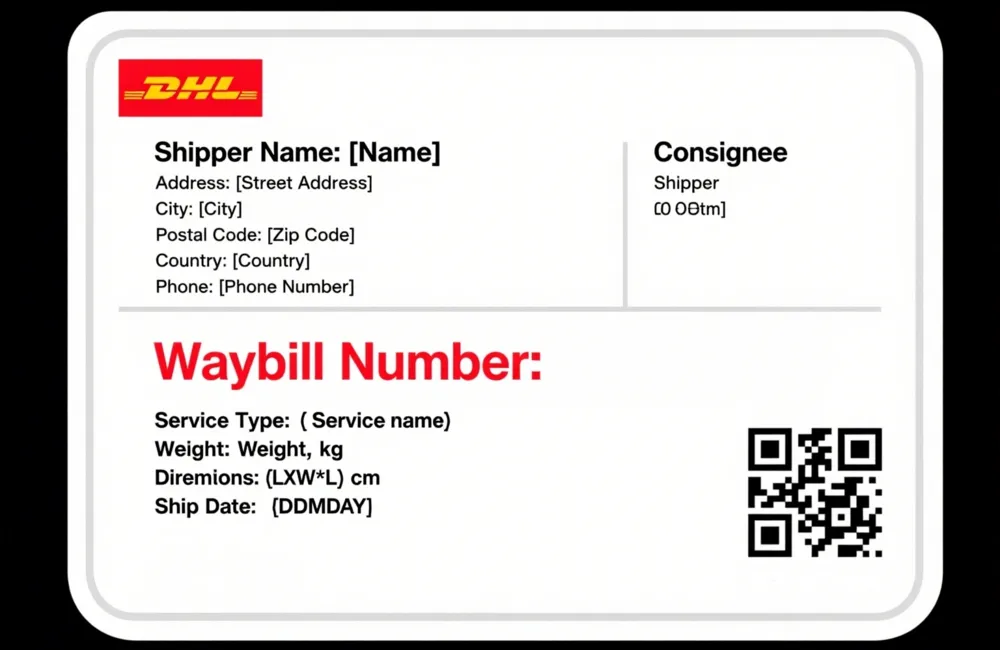
Printing at Home
A lot of people print shipping labels printable at home. This saves both money and time. Home printing is great for small businesses. It also helps anyone who ships packages often. The printer you use matters a lot. There are three main types: inkjet, laser, and thermal. Each one has its own good points.
Printer Type | Common Use for Shipping Labels at Home | Advantages |
|---|---|---|
Inkjet | Good for short runs and colorful labels | Bright colors; cheap for small jobs; nice for branding |
Laser | Best for lots of text-heavy labels | Prints fast; saves money on text; labels do not smudge |
Thermal | Most used for shipping labels and barcodes | Labels last through rough use; low upkeep; good for many labels |
Thermal printers are the best for shipping labels printable. They make labels that can handle rough trips and bad weather. Laser printers are quick and make clear text. This helps with barcodes. Inkjet printers are good for colorful labels. But they are not used as much for shipping labels printable.
Label size is important too. The 4×6 inch label is the most common in the U.S. It holds all the info carriers need. Other sizes like 4×4.25 and 4×8 inches are used for special needs or extra info.
Label Size (inches) | Description | Usage and Compatibility |
|---|---|---|
4×4.25 | Small parcel labels | Used for tiny packages like jewelry or medicine; not used by all services. |
4×6 | Standard label | Most used size; works with all big carriers; fits all needed info. |
4×8 | Versatile label | Holds more info than needed; used for barcodes, logos, or notes. |
Larger Collated Labels | Big shipping documents | Used for big orders; can have many labels and extra info on one sheet. |
Printing at home is cheaper than going to a store. A thermal printer can print a label for just 3-5 cents. A regular printer costs about 5-10 cents per label. People who print lots of labels each month save the most money.
Printing Method | Cost per Label | Monthly Cost Example (500 labels) | Notes |
|---|---|---|---|
Thermal Shipping Label Printer (Home) | 3-5 cents | $15-$25 | No ink needed, lasts long, good for lots of labels |
Standard Desktop Printer (Home) | 5-10 cents | $25-$50 | Needs ink, uses label sheets, wears out faster |
Pre-printed Custom Labels (Retail) | N/A | $450+ (for 75 packages/week) | Costs a lot for branding and ease, not good for many labels |
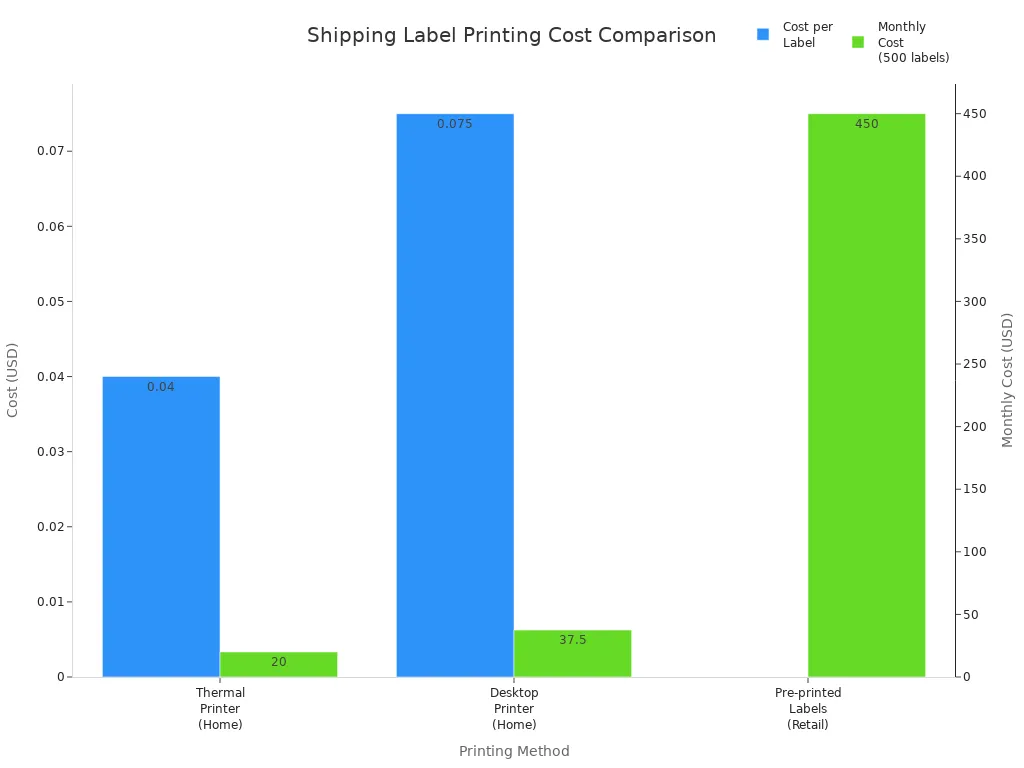
People can use free label printing from USPS Click-N-Ship. Many online tools give discounts on postage. You do not need a special printer to start. Most people use a regular printer first. They switch to thermal printers when they ship more.
Tip: Always check your printer settings and label size before you print. Print a test page on plain paper so you do not waste labels.
Printing at Stores
Some people print shipping labels printable at stores. This is good for those who ship only a few packages. It also helps if you do not have a printer at home. Stores like The UPS Store and FedEx Office print labels for you. You can email your label file or show a QR code. The staff will print the label for a small fee.
Printing at stores costs more than printing at home. For example, printing 500 labels at home with a thermal printer costs about $15-$25 a month. The same number of labels from a store can cost over $450. Store printing is easy for one-time shipments or if your printer breaks.
Note: Store printing is best for people who ship rarely or need help with special labels. If you ship often, printing at home saves more money.
Best Practices
Printing shipping labels printable at home or in a store works best if you follow some simple rules. Mistakes can cause lost or late packages. Here are some common mistakes and how to avoid them:
Choose the right printer for your needs. Thermal printers are best for lots of labels. Inkjet and laser printers are fine for small amounts.
Use the right label sheets. Make sure they fit your printer and what the carrier wants.
Load label sheets the right way. Follow your printer’s guide to stop jams and crooked labels.
Set your printer for the right label size. Pick high-quality print settings for clear labels.
Print a test page first. Check if things line up and look good before using real labels.
Clean your printer often. This keeps it working well.
Use strong, good labels. These last longer and scan better.
Fix problems fast. Check ink, change settings, and update drivers if needed.
Big carriers also suggest these tips:
Make labels simple. Make the address and tracking number easy to see.
Use strong, weatherproof labels. Waterproof and tamper-proof labels work best.
Put labels on flat, clean spots. Do not put them on seams or edges.
Print clear barcodes. This helps with tracking and delivery.
Cover labels with clear tape or covers. This keeps them safe from water and scratches.
Check labels in different lights. Make sure they are easy to read and scan.
Tip: Always double-check addresses and tracking numbers before you print. Automation tools can help you find mistakes and save time.
Shipping labels printable help people send packages faster and for less money. By picking the right printer, using the right label size, and following these tips, anyone can make good labels at home or in a store.
After Attaching the Label
Drop-Off or Pickup
After you put on the shipping label, you need to give the package to the carrier. You can take it to a carrier store or ask for a pickup. Each carrier has its own way, but the steps are simple.
Drop-Off at Carrier Locations
Most people bring packages to a post office, FedEx, or UPS store. Many stores have machines you can use by yourself. These kiosks make things fast and easy. Here is how each carrier does drop-offs:
Carrier | Self-Service Kiosk Drop-Off Procedure |
|---|---|
USPS | Many lobbies have kiosks open all day and night. You scan or type in the label or QR code. Put your package in the right spot if it fits (no bigger than 12″x14″x20″). It does not cost extra. Kiosks can weigh, print postage, and give you a receipt. |
FedEx | Use Ship and Go kiosks at FedEx Office. Scan the shipping label or QR code. Print a receipt and drop off your package. You do not have to wait in line. |
UPS | Find a UPS Self-Service Kiosk. Scan the label or QR code. Follow the steps, print a receipt, and put the package in the drop box. |
For FedEx, pack and seal your box well. Take off old labels. Put the new label on the biggest side. Boxes smaller than 20″ x 12″ x 6″ fit in drop boxes.
Scheduling a Pickup
If you cannot go to a store, you can ask for a pickup. Carriers let you set up pickups online, with an app, or by phone. Here is a quick guide:
Courier | How to Schedule Pickup | Pickup Types | Fees | Restrictions |
|---|---|---|---|---|
USPS | Online, app, or phone | Next day (free), same day ($24) | Free or $24 | No hazardous or big packages |
FedEx | App or Ship Manager | One-time, recurring | $3-$4 per package | No hazardous items, strong packaging |
UPS | Online or call | One-time, recurring | $5.80-$6.80 | Extra fees for far away pickups |
Tip: Pickups save time if you have heavy or many packages.
Tracking and Delivery
After drop-off or pickup, the carrier takes care of the package. The barcode on the shipping label is very important. Here is how tracking works:
The sender makes and puts on the label.
The carrier scans the barcode at every stop. This updates tracking for both sender and receiver.
The label helps the package go the right way.
The driver checks the label before delivery.
You can track your package online or with carrier apps. Updates show when the package leaves, travels, and gets delivered.
Delivery times change based on the service. Here is a quick look:
USPS Shipping Service | Average Delivery Time |
|---|---|
Priority Mail Express® | Overnight to most places |
Priority Mail® | 1 – 3 business days |
First-Class Package Service® | 1 – 3 business days |
USPS Retail Ground | 2 – 8 business days |
FedEx Standard Shipping Service | Delivery Timeframe |
|---|---|
FedEx Ground (Contiguous U.S.) | 1 – 5 business days |
FedEx Ground (Alaska & Hawaii) | 3 – 7 business days |
Packages move faster when labels are clear and easy to scan. Tracking lets everyone know where the package is and helps stop worries about lost packages.
Troubleshooting & Tips
Reprinting and Expiration
Sometimes, you need to print a shipping label again. This happens for a few reasons:
The label expired after the “ship by” date, so the carrier will not take it.
The label has mistakes or is hard to read, which can cause delivery problems.
The shipment was canceled or delayed, so the label needs to be voided or printed again.
Big carriers have different rules for when labels expire. Here is a quick look:
Carrier | Typical Expiration Time for Shipping Label |
|---|---|
USPS | Some post offices reject labels older than 1 day. Use labels soon after making them. |
UPS | Labels usually expire after 100 days. Old labels may send packages to a lost items center. Make a new label if you are not sure. |
FedEx | Emailed labels can be printed for up to 2 years. Most expire 2 weeks after printing. |
Many shipping websites want you to use strict shipping dates. This helps you avoid extra fees. To stop problems, make and attach labels right before you ship.
Common Mistakes
People often make the same mistakes with shipping labels. Here is a table of common errors and how to fix them:
Frequent Errors Encountered | Recommended Solutions |
|---|---|
Printing is crooked or cut off | Check printer settings and use the right label size. |
Labels do not stick well | Use strong sticky labels and put them on clean, flat spots. |
Labels get smudged | Use the right label for your printer and pick waterproof labels. |
Barcodes do not scan | Place labels flat, cover old labels, and use dark ink. |
Labels are in the wrong spot | Put labels on the biggest, flattest side, away from seams. |
Clear tape over labels | Do not use clear tape over the label, as it can make scanning hard. |
Wrong label details can cause delivery problems and extra costs. Carriers might charge $18–21 for fixing address mistakes. Automation tools help by checking addresses and barcodes before you print.
Practical Tips
Shipping experts suggest these steps for easy shipping:
Check all label details, like the full address and apartment numbers.
Use strong boxes and take off old labels before shipping.
Wrap breakable items well so they do not break.
Use online tools to make labels that are easy to scan.
Put the label on top of the package where it is easy to see.
Protect labels with clear tape only on the edges, not over the barcode.
Compare shipping prices to save money.
Put a note with both addresses inside the box as a backup.
Use thermal printers for clear, smudge-free labels if you can.
Print many labels at once to save time and make fewer mistakes.
Remember: Good labels help packages get there safely and on time. Small steps now can stop big problems later.
Shipping labels printable help people ship things faster and save money. They also make sure packages go to the right place. Businesses like using custom labels and can fill orders quickly. This means they make fewer mistakes. Customers can track their packages as they move. This makes delivery better for everyone. To stop problems, people should check where the barcode goes. They should also use tools to check addresses and follow carrier rules. Many tools, such as Avery, Canva, and ShippingEasy, make it easy to create labels.
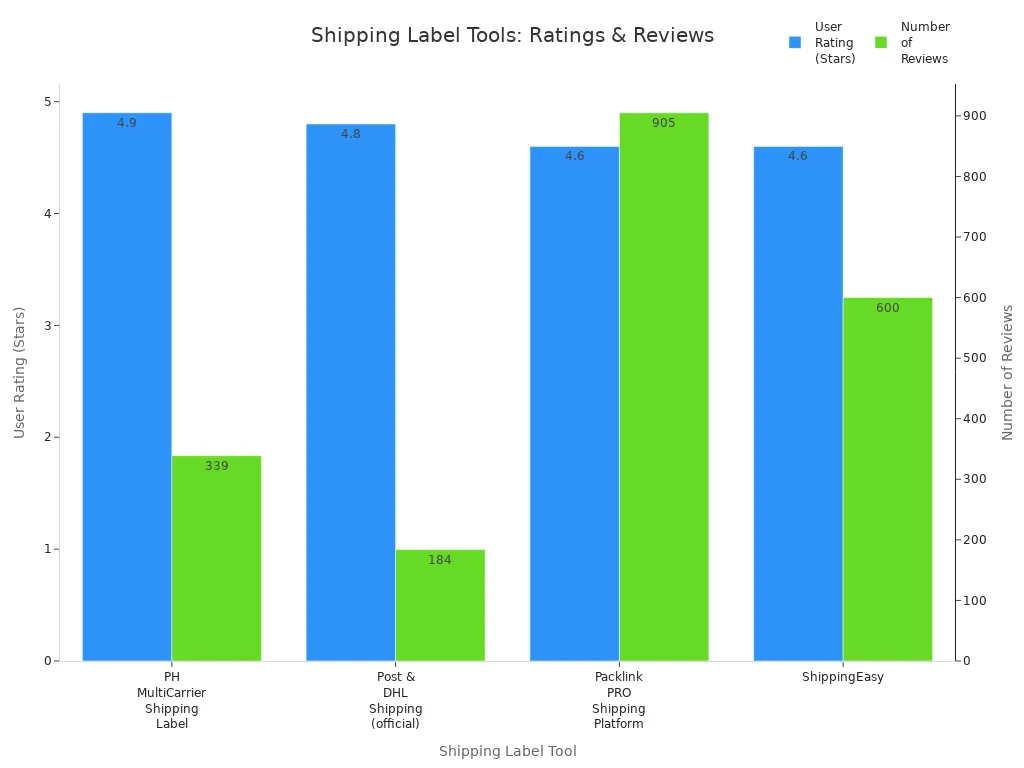
Try out different templates and software to see what works best for you.
FAQ
How can someone reprint a lost shipping label?
If you lose a shipping label, log in to your shipping tool or carrier website. Most sites let you see old labels and print them again. Always look at the expiration date before you print it again.
What should a person do if the barcode will not scan?
A barcode that is blurry or broken can cause trouble. Try printing the label again using better print settings. Put the label flat on the box. Do not put tape over the barcode.
Can a person handwrite a shipping label?
Yes, some carriers let you handwrite a shipping label. Write neatly and add the full address and return address. Handwritten labels do not have tracking barcodes, so delivery might be slower.
What size label works best for most packages?
A 4×6 inch label fits most packages and works with all big carriers. This size has enough room for addresses, barcodes, and tracking numbers. Most online tools and printers can use this size.
Is it possible to print shipping labels from a phone?
Yes! Many shipping apps and carrier websites let you make and print labels from your phone. You can connect your phone to a wireless printer or email the label to a store to print.
Tip: Always check the label details before you ship. Mistakes can slow down delivery.
